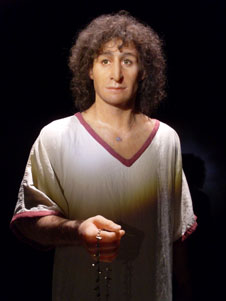 Thursday 26 May 2016 10:20am
Thursday 26 May 2016 10:20am
Young Man of Byrsa (life reconstruction)
A research team co-led by a University of Otago scientist Lisa Matisoo-Smith and by a Lebanese American University scientist, Pierre Zalloua, has sequenced the first complete mitochondrial genome of a 2500-year-old Phoenician dubbed the “Young Man of Byrsa” or “Ariche”, whose tomb was discovered within a hill in Carthage, Tunisia in 1994.
This is the first ancient DNA to be obtained from Phoenician remains and the team's analysis shows that the man carried a rare European haplogroup that likely links his maternal ancestry to locations somewhere on the North Mediterranean coast, most likely on the Iberian Peninsula.
The findings are newly published in the prestigious international journal PLOS ONE.
Professor Lisa Matisoo-Smith says that the findings provide the earliest evidence of the European mitochondrial haplogroup U5b2cl in North Africa and date its arrival to at least the late sixth century BC.
“U5b2cl is considered to be one of the most ancient haplogroups in Europe and is associated with hunter-gatherer populations there. It is remarkably rare in modern populations today, found in Europe at levels of less than one percent. Interestingly, our analysis showed that Ariche's mitochondrial genetic make-up most closely matches that of the sequence of a particular modern day individual from Portugal,” Professor Matisoo-Smith says.
While the Phoenicians are thought to have originated from the area that is now Lebanon, their influence expanded across the Mediterranean and west to the Iberian peninsula where they established settlements and trading posts. The city of Carthage in Tunisia, North Africa, was established as a Phoenician port by colonists from Lebanon and became the centre for later Phoenician (Punic) trade.
The researchers analysed the mitochondrial DNA of 47 modern Lebanese people and found none were of the U5b2c1 lineage.
Previous research has found that U5b2c1 was present in two ancient hunter-gatherers recovered from an archaeological site in North-western Spain, she says.
“While a wave of farming peoples from the Near East replaced these hunter-gatherers, some of their lineages may have persisted longer in the far south of the Iberian peninsula and on off-shore islands and were then transported to the melting pot of Carthage in North Africa via Phoenician and Punic trade networks.”
Professor Matisoo-Smith says Phoenician culture and trade had a significant impact on Western civilisation, for example, they introduced the first alphabetic writing system.
“However, we still know little about the Phoenicians themselves, except for the likely biased accounts by their Roman and Greek rivals — hopefully our findings and other continuing research will cast further light on the origins and impact of Phoenician peoples and their culture,” she says.
This scientific discovery reveals that population movement from South Western Europe into North Africa existed at the time of the Phoenician settlements in Carthage. “The evidence points out that this individual either adopted Punic culture or was born into it,” says Zalloua.
One of the most fascinating aspects of the study, according to both scientists, was the ability to analyse the DNA of an individual who had been excavated years prior. The grave was discovered in 1994 on Byrsa hill, near Carthage, Tunisia. The tomb dates to the late 6th century BCE where the remains of the 'young man of Byrsa' were found. Zalloua goes on to explain that this finding is part of a wider study which involves collecting Phoenician remains from different sites for analysis.
The project was an international collaboration of researchers from New Zealand, Lebanon and Tunisia led by Pierre Zalloua, of the Lebanese American University and Lisa Matisoo-Smith, of the University of Otago. Co-authors include Anna Gosling, James Boocock, and Olga Kardailsky from the University of Otago; Yara Kurumilian, of LAU; Sihem Roudesli-Chebbi and Leïla Ladjimi Sebaï, of the National Heritage Institute of Tunisia; Leila Badre, of the Archaeological Museum at the American University of Beirut, and Jean-Paul Morel, of the Université d'Aix-Marseille, France.
More information about Ariche
An image of his life reconstruction
For more information, contact:
Professor Lisa Matisoo-Smith
Professor of Biological Anthropology
Department of Anatomy
University of Otago
Tel 03 479 6827
Mob 021 279 6827
Email lisa.matisoo-smith@otago.ac.nz
A list of Otago experts available for media comment is available elsewhere on this website.
Electronic addresses (including email accounts, instant messaging services, or telephone accounts) published on this page are for the sole purpose of contact with the individuals concerned, in their capacity as officers, employees or students of the University of Otago, or their respective organisation. Publication of any such electronic address is not to be taken as consent to receive unsolicited commercial electronic messages by the address holder.